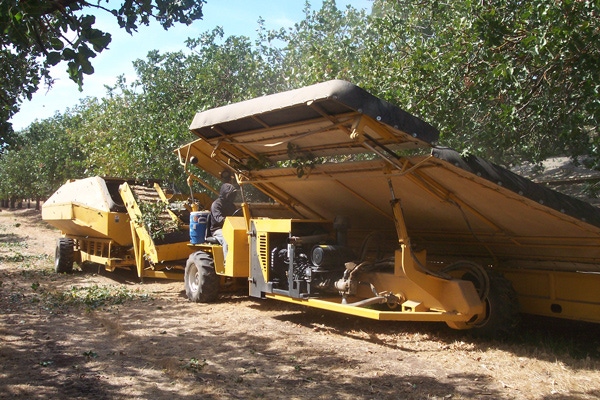
“The lack of lateral branching causes the fruit-bearing wood to become increasingly distant from the central axis of the tree,” Beede says. “Failure to contain the tree canopy to a diameter of about 17 feet results in crop falling onto the ground at harvest due to the limited size of the harvest equipment.”

A good pistachio pruning program manages the canopy over the life of the orchard in a way that maximizes the possible yield of clean, open split-nuts from an efficient harvest, says Bob Beede, University of California Cooperative Extension farm advisor, emeritus, for Kings County.
To better manage alternate bearing, he prefers to think of pruning in terms of two years, rather than just the next year. “Pruning harder prior to an on-year improves the yield during an off-year, in my opinion,” Beede says. UC researchers are now testing that hypothesis.
Both growth and fruiting habits of the pistachio tree affect pruning. As a very apical dominant tree, it does not branch readily. Instead, the tree grows mostly from the terminal bud and one or two lateral buds behind it, he notes. Consequently, branching must be forced by removing the end portion of a limb. Such heading cuts are made regularly during the training years to develop the desired branching.
Also due to the pistachio tree’s apically dominant nature, the trunk and limb diameter do not enlarge rapidly. That requires heading the main structural limbs shorter than desired to keep them upright, Beede adds
Flower buds develop on one-year-old wood, typically towards the base of medium to long shoots and next to the terminal vegetative bud on short shoots (spurs). “The lack of lateral branching causes the fruit-bearing wood to become increasingly distant from the central axis of the tree,” Beede says. “Failure to contain the tree canopy to a diameter of about 17 feet results in crop falling onto the ground at harvest due to the limited size of the harvest equipment.”
Eventually, during the on-bearing seasons the weight of the crop forces the main structural limbs to bend downward. Without corrective pruning, the pistachio tree canopy begins to take on the appearance of an umbrella, Beede notes
“This combination of less-upright fruiting limbs and their greater distance from the tree’s center creates major problems for effective harvest,” he says. “The high energy imparted to the trunk by the shaker can no longer be sufficiently transmitted to the fruiting zone for its removal.”
Some growers try to solve this by simply shaking the tree harder. The result, he points out, is more frequent equipment breakage, rapid sling wear (the thick rubber sheets draped around the shaker pads for protection), excessive removal of next year’s fruiting wood (spurs) and, possibly, more tree stress from disruption of roots at the tree’s crown. Harder shaking also flings the crop past the catch frame of the harvester.
This can be prevented by pruning the pistachio tree so as to push the canopy perimeter back, reducing its diameter and directing growth upward, Beede reports. That’s done mainly with thinning cuts, which completely remove a limb at its point of origin.
“To achieve a more compact and upright tree, thinning cuts are made to flat limbs around the outside of the tree and within the canopy where excessive fruitwood exits,” Beede says. “Be careful not to make too many cuts in any given sector of the canopy unless the fruitwood is unusually abundant. In addition to distributing the thinning cuts over the entire tree, avoid removing all of the lateral limbs on a specific structural branch in order to make room for adjacent branches. Rather than creating these so-called snakes, it is better to leave the best structural branch minimally pruned and to remove the competing branch entirely.”
Also, he cautions against opening the center of pistachios trees. “We do not want them to look like peach trees at the completion of pruning,” Beede says. “Because of their growth and fruiting habits, pistachio trees will open up naturally, allow sufficient light into the canopy center for fruitwood production.”
He considers loss of fruitwood in the middle of the tree over time as more a function of apical dominance than insufficient light penetration. The key in pruning is to keep the pistachio canopy compact and upright for productivity and harvestability.
“Don’t prune mature trees to the point that they produce lots of long whips,” he says. “Although this looks good, it most likely means that the tree has been over pruned.
Research shows that the pistachio tree has preformed shoots. They set seven to nine bud positions before the season begins. Unless the tree is excessively vigorous, these preformed shoots grow into spurs and set lots of crop, he explains.
“If mature trees are over-pruned, these preformed shoots are “pushed” into continued growth,” Beede says. “I believe the most productive pistachio tree is one that has hundreds of these short, preformed shoots, rather than lots of long whips.”
About the Author(s)
You May Also Like



